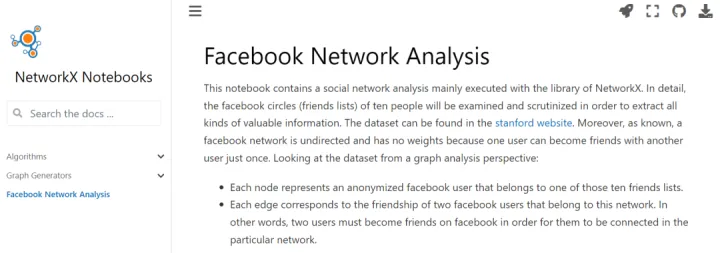前言:下期给我们撷取NetworkX非官方得出的SNSABM事例:FacebookABM[1],以更进一步增进对繁杂互联网基本知识的认知。
那个笔记本电脑包涵了三个SNSABM,主要就是用NetworkX的库继续执行的。简而言之,将对10对个人的facebook圈子里(挚友条目)展开检查审核,以抽取各式各样有用的重要信息。统计数据集能在麻省理工学院的中文网站上[2]找出。除此之外,不可否认,facebook互联网是无向的,没权重股,因为三个采用者可能将只与另三个采用者正式成为一场挚友。从图象预测的视角上看统计数据集:
★ 每一结点代表者三个非官方的facebook采用者,他归属于这六个挚友条目中的三个。
★ 每一边都相关联着归属于那个互联网的三个facebook采用者的情谊。换言之,三个采用者要在facebook上正式成为挚友就能在某一的互联网中相连。
上面得出非官方的jupyter notebook实例标识符:
具体来说,引入必要性的库:
import pandas as pd
import numpy as np
import networkx as nx
import matplotlib.pyplot as plt
from random import randint
从统计数据配置文件读取Minervois统计数据,每一边都是三个LX1,每一边都有三个start_node和三个end_node列:
facebook = pd.read_csv(
"data/facebook_combined.txt.gz",
compression="gzip",
sep=" ",
names=["start_node", "end_node"],
)
创建互联网:
G = nx.from_pandas_edgelist(facebook, "start_node", "end_node")
可视化互联网:即使我们对统计数据的结构没任何真正的感觉,所以让我们从采用random_layout查看互联网,这是最快的布局函数之一。
fig, ax = plt.subplots(figsize=(15, 9))
ax.axis("off")
plot_options = {"node_size": 10, "with_labels": False, "width": 0.15}nx.draw_networkx(G, pos=nx.random_layout(G), ax=ax, **plot_options)
生成的图不是很有用,这种图可视化有时被通俗地称为“毛球”,即使重叠的边会导致纠缠的混乱。
很明显,如果我们想要获得统计数据的感觉,我们需要在定位上施加更多的结构。为此,我们能采用spring_layout函数,它是networkx绘图模块的默认布局函数。spring_layout函数的优点是它考虑了结点和边来计算结点的位置。然而,缺点是那个过程的计算成本要高得多,而且对于有100个结点和1000个边的图来说会非常慢。
由于我们的数据集有超过80k条边,我们将限制spring_layout函数中采用的迭代次数,以减少计算时间。我们还将保存计算出来的布局,以便在将来的可视化中采用它。
pos = nx.spring_layout(G, iterations=15, seed=1721)
fig, ax = plt.subplots(figsize=(15, 9))
ax.axis("off")
nx.draw_networkx(G, pos=pos, ax=ax, **plot_options)
★ 获取互联网的基本拓扑属性:
# 结点数量
G.number_of_nodes()
4039
# Minervois数量
G.number_of_edges()
88234
np.mean([d for _, d in G.degree()])
43.69101262688784
shortest_path_lengths = dict(nx.all_pairs_shortest_path_length(G))
# Length of shortest path between nodes 0 and 42
shortest_path_lengths[0][42]
1
diameter = max(nx.eccentricity(G, sp=shortest_path_lengths).values())
diameter
8
# Compute the average shortest path length for each node
average_path_lengths = [
np.mean(list(spl.values())) for spl in shortest_path_lengths.values()
]
# The average over all nodes
np.mean(average_path_lengths)3.691592636562027
上述结果代表者了所有结点对最短路径长度的平均值:为了从三个结点到达另三个结点,平均大约要遍历3.6条边。
上面的度量捕获了关于互联网的有用重要信息,但是像平均值这样的度量只代表者了分布的三个时刻。我们能通过预先计算的dict-of-dicts构建三个最短路径长度分布的可视化:
# We know the maximum shortest path length (the diameter), so create an array
# to store values from 0 up to (and including) diameter
path_lengths = np.zeros(diameter + 1, dtype=int)
# Extract the frequency of shortest path lengths between two nodes
for pls in shortest_path_lengths.values():
pl, cnts = np.unique(list(pls.values()), return_counts=True)
path_lengths[pl] += cnts
# Express frequency distribution as a percentage (ignoring path lengths of 0)
freq_percent = 100 * path_lengths[1:] / path_lengths[1:].sum()
# Plot the frequency distribution (ignoring path lengths of 0) as a percentage
fig, ax = plt.subplots(figsize=(15, 8))
ax.bar(np.arange(1, diameter + 1), height=freq_percent)
ax.set_title(
"Distribution of shortest path length in G", fontdict={"size": 35}, loc="center"
)
ax.set_xlabel("Shortest Path Length", fontdict={"size": 22})
ax.set_ylabel("Frequency (%)", fontdict={"size": 22})
大多数最短路径的长度是从2条边到5条边的长度。除此之外,对于一对结点来说,其最短路径长度为8(直径长度)的可能将性非常小,即使其可能将性小于0.1%。
计算图的密度,显然,这是三个非常稀疏的图。以及图包涵组件的数量,正如预期的那样,那个互联网由三个巨大的组件组成:
nx.density(G)
0.010819963503439287
nx.number_connected_components(G)1
接下来,对facebook互联网的中心性指标展开研究:
★ 度中心性:度中心性简单地根据每一结点所拥有的链接数量分配三个重要分数。在那个预测中,这意味着三个结点的中心性程度越高,相连到该结点的边越多,因此该结点的邻居结点(facebook挚友)也越多。事实上,三个结点的中心性程度就是它所相连的结点的分数。换言之,它是互联网中某一结点与交友关系的百分比。
具体来说,我们找出中心度最高的结点。其中,8个度中心性最高的结点及其度中心性如下图所示:
degree_centrality = nx.centrality.degree_centrality(G)
# save results in a variable to use again
(sorted(degree_centrality.items(), key=lambda item: item[1], reverse=True))[:8]
[(107, 0.258791480931154),
(1684, 0.1961367013372957),
(1912, 0.18697374938088163),
(3437, 0.13546310054482416),
(0, 0.08593363051015354),
(2543, 0.07280832095096582),
(2347, 0.07206537890044576), (1888, 0.0629024269440317)]
现在我们还能看到中心度最高的结点的邻居数量:
(sorted(G.degree, key=lambda item: item[1], reverse=True))[:8]
[(107, 1045),
(1684, 792),
(1912, 755),
(3437, 547),
(0, 347),
(2543, 294),
(2347, 291),
(1888, 254)]
绘制出程度中心性的分布:
plt.figure(figsize=(15, 8))
plt.hist(degree_centrality.values(), bins=25)
plt.xticks(ticks=[0, 0.025, 0.05, 0.1, 0.15, 0.2]) # set the x axis ticks
plt.title("Degree Centrality Histogram ", fontdict={"size": 35}, loc="center")
plt.xlabel("Degree Centrality", fontdict={"size": 20})
plt.ylabel("Counts", fontdict={"size": 20})
现在让我们根据结点的大小来检查中心度最高的采用者:
node_size = [
v * 1000 for v in degree_centrality.values()
] # set up nodes size for a nice graph representation
plt.figure(figsize=(15, 8))
nx.draw_networkx(G, pos=pos, node_size=node_size, with_labels=False, width=0.15)
plt.axis("off")

★ 介数中心性:
betweenness_centrality = nx.centrality.betweenness_centrality(
G
) # save results in a variable to use again
(sorted(betweenness_centrality.items(), key=lambda item: item[1], reverse=True))[:8]
[(107, 0.4805180785560152),
(1684, 0.3377974497301992),
(3437, 0.23611535735892905),
(1912, 0.2292953395868782),
(1085, 0.14901509211665306),
(0, 0.14630592147442917), (698, 0.11533045020560802), (567, 0.09631033121856215)]
plt.figure(figsize=(15, 8))
plt.hist(betweenness_centrality.values(), bins=100)
plt.xticks(ticks=[0, 0.02, 0.1, 0.2, 0.3, 0.4, 0.5]) # set the x axis ticks
plt.title("Betweenness Centrality Histogram ", fontdict={"size": 35}, loc="center")
plt.xlabel("Betweenness Centrality", fontdict={"size": 20})
plt.ylabel("Counts", fontdict={"size": 20})

按照介数值的大小展开互联网可视化:
node_size = [
v * 1200 for v in betweenness_centrality.values()
] # set up nodes size for a nice graph representation
plt.figure(figsize=(15, 8))
nx.draw_networkx(G, pos=pos, node_size=node_size, with_labels=False, width=0.15)
plt.axis("off")

★ 接近度中心性:
closeness_centrality = nx.centrality.closeness_centrality(
G
) # save results in a variable to use again
(sorted(closeness_centrality.items(), key=lambda item: item[1], reverse=True))[:8]
[(107, 0.45969945355191255),
(58, 0.3974018305284913),
(428, 0.3948371956585509),
(563, 0.3939127889961955),
(1684, 0.39360561458231796),
(171, 0.37049270575282134),
(348, 0.36991572004397216), (483, 0.3698479575013739)]
# 除此之外,三个某一结点v到任何其他结点的平均距离也能很容易地用公式求出:1 / closeness_centrality[107]2.1753343239227343
plt.figure(figsize=(15, 8))
plt.hist(closeness_centrality.values(), bins=60)
plt.title("Closeness Centrality Histogram ", fontdict={"size": 35}, loc="center")
plt.xlabel("Closeness Centrality", fontdict={"size": 20})
plt.ylabel("Counts", fontdict={"size": 20})

node_size = [
v * 50 for v in closeness_centrality.values()
] # set up nodes size for a nice graph representation
plt.figure(figsize=(15, 8))
nx.draw_networkx(G, pos=pos, node_size=node_size, with_labels=False, width=0.15)
plt.axis("off")
以及特征向量中心性等中心性指标,用类似的方式即可获取上述图象。
★ 集聚系数:
# 平均集聚系数
nx.average_clustering(G)
0.6055467186200876
plt.figure(figsize=(15, 8))
plt.hist(nx.clustering(G).values(), bins=50)
plt.title("Clustering Coefficient Histogram ", fontdict={"size": 35}, loc="center")
plt.xlabel("Clustering Coefficient", fontdict={"size": 20})
plzt.ylabel("Counts", fontdict={"size": 20})

★ 桥:
nx.has_bridges(G)
True
# 输出桥的数量
bridges = list(nx.bridges(G))len(bridges)
75
plt.figure(figsize=(15, 8))nx.draw_networkx(G, pos=pos, node_size=10, with_labels=False, width=0.15)nx.draw_networkx_edges( G, pos, edgelist=local_bridges, width=0.5, edge_color="lawngreen") # green color for local bridgesnx.draw_networkx_edges( G, pos, edgelist=bridges, width=0.5, edge_color="r") # red color for bridgesplt.axis("off")
★ 互联网关联系数:
nx.degree_assortativity_coefficient(G)0.06357722918564943nx.degree_pearson_correlation_coefficient(G) 0.06357722918564918
★ 互联网社区:社区是一组结点,因此组内的结点相连
的边要比组间相连的边多得多。该互联网将采用两种不
同的算法展开社区检测。
具体来说,采用半同步标签传播方法检测社区:
该函数自行确定将检测到的社区数量。现在将遍历社
区,并创建三个颜色条目,为归属于同三个社区的结点
包涵相同的颜色。除此之外,社区的数量也被打印出来:
colors = ["" for x in range(G.number_of_nodes())] # initialize colors listcounter = 0for com in nx.community.label_propagation_communities(G): color = "#X" % randint(0, 0xFFFFFF) # creates random RGB color counter += 1 for node in list( com ): # fill colors list with the particular color for the community nodes colors[node] = colorcounter44plt.figure(figsize=(15, 9))plt.axis("off")nx.draw_networkx( G, pos=pos, node_size=10, with_labels=False, width=0.15, node_color=colors)
其次,采用异步流体团体算法:
colors = ["" for x in range(G.number_of_nodes())]for com in nx.community.asyn_fluidc(G, 8, seed=0): color = "#X" % randint(0, 0xFFFFFF) # creates random RGB color for node in list(com): colors[node] = colorplt.figure(figsize=(15, 9))plt.axis("off")nx.draw_networkx( G, pos=pos, node_size=10, with_labels=False, width=0.15, node_color=colors)[1] https://networkx.org/nx-guides/content/exploratory_notebooks/facebook_notebook.html#id2[2] http://snap.stanford.edu/data/ego-Facebook.html
本文采用 文章同步助手 同步











 百万个冷知识
百万个冷知识
.jpg)
.jpg)
.jpg)

.jpg)

.jpg)
.jpg)
.jpg)


.jpg)
.jpg)
.jpg)
.jpg)
.jpg)
.jpg)
.jpg)
.jpg)
.jpg)
.jpg)
.jpg)
.jpg)
.jpg)
.jpg)
.jpg)
.jpg)
.jpg)
.jpg)

.jpg)
.jpg)
